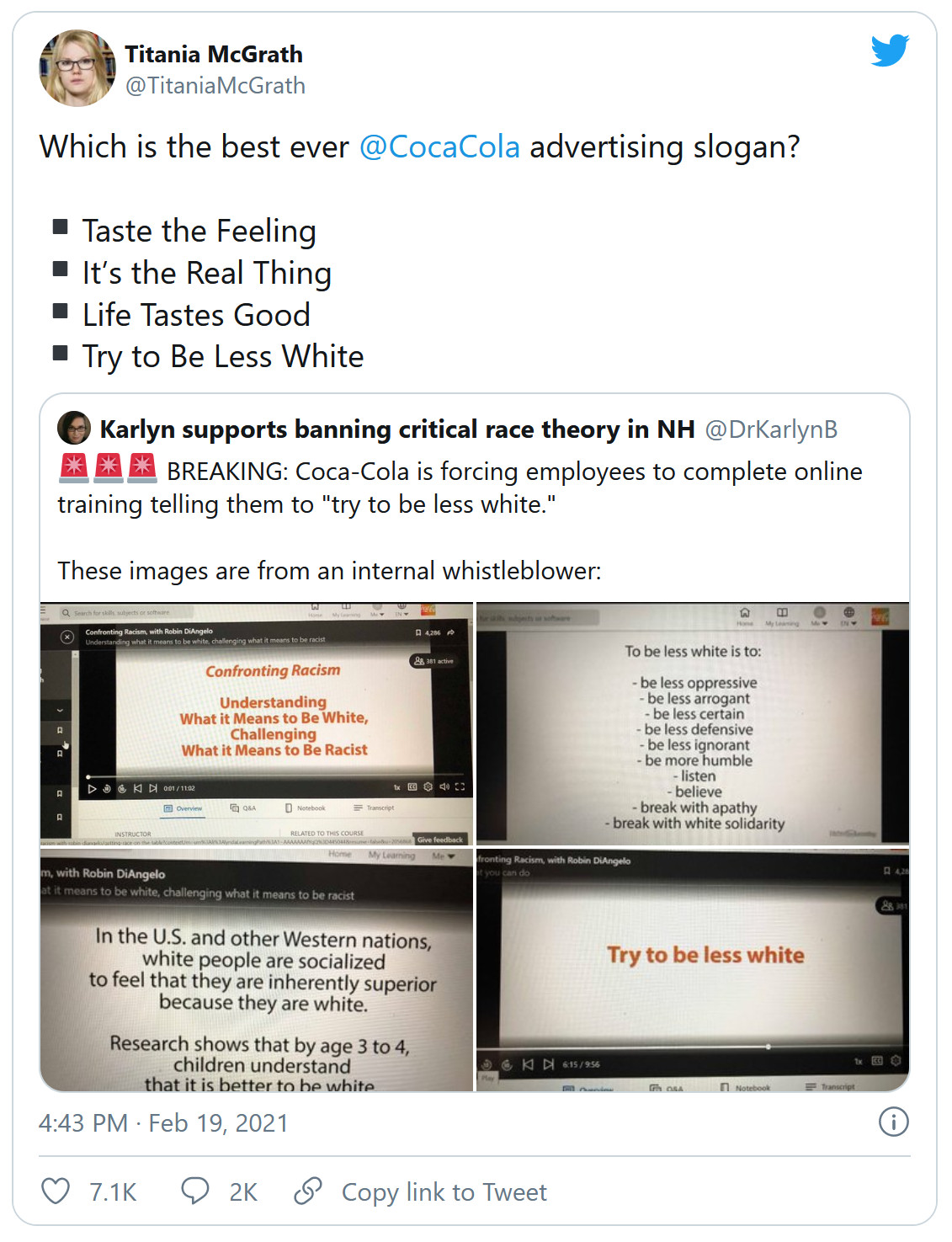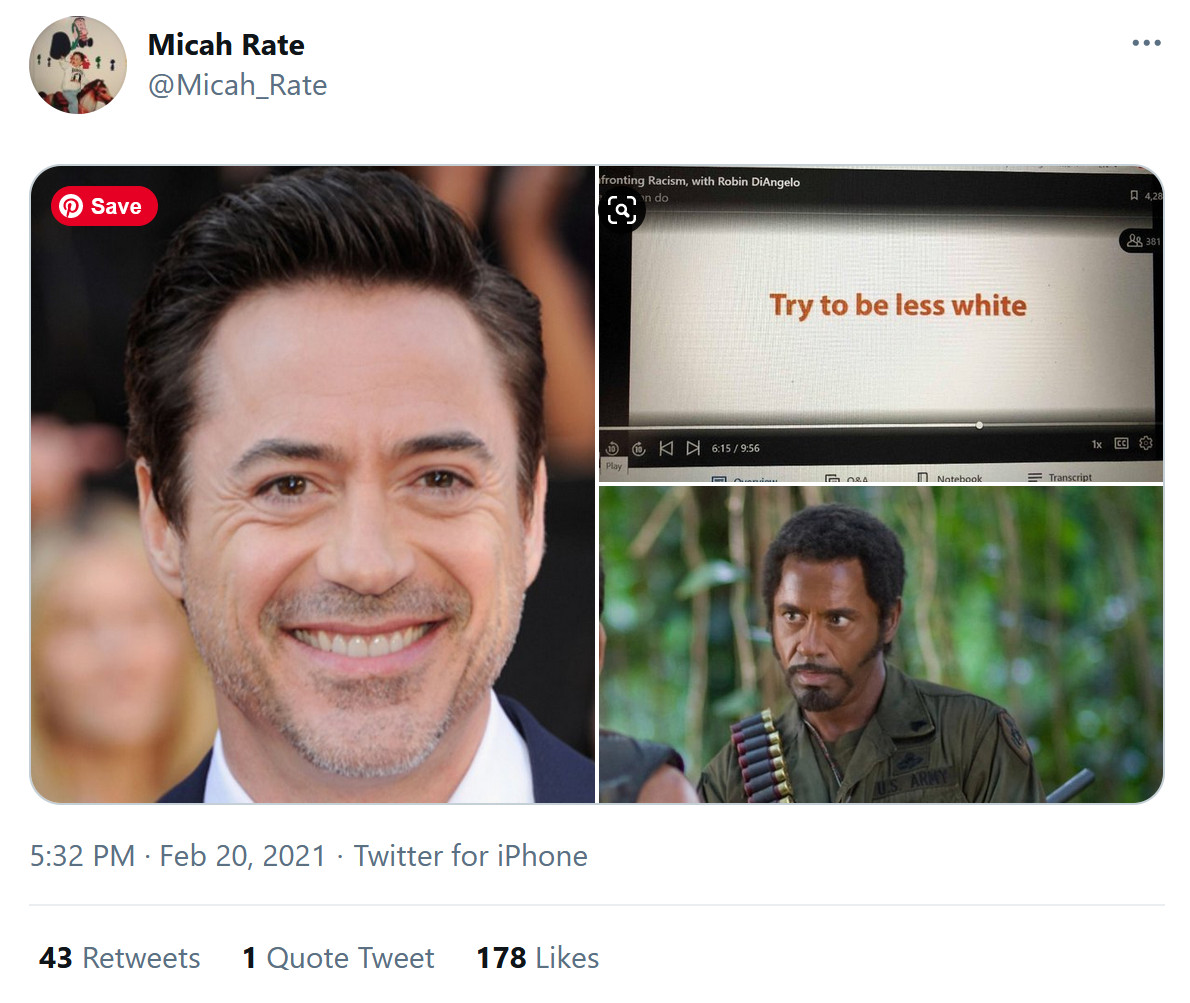DON’T TRUST COLLEGE PRESIDENTS: Public records show college president invented pressure from ‘legislators’ in response to professor’s tweets.
Archive for 2021
February 21, 2021
SPREADING MISINFORMATION: Pelosi’s ‘9/11-style panel’ for Capitol riot is just a bid to sell her pet conspiracy theories.
HAVE A COKE AND A RACISM LECTURE. ‘Be Less White:’ Uncovering White Fragility Author Robin DiAngelo’s LinkedIn Course On ‘Confronting Racism.’

More: Strange new respect for Robert Downey Jr?

UPDATE (FROM GLENN): Related: The Wages of Woke: How Robin DiAngelo got rich peddling ‘white fragility.’
‘HUGE AMOUNT’ OF LAWMAKERS, STAFF SEEKING THERAPY AFTER CAPITOL RIOT.
As Benjamin Weingarten of the Federalist tweets in response, “Now imagine the long-term psychological damage done to thousands if not millions of Americans by the political class, whose lives were wrecked by the arbitrary, capricious, draconian lockdowns senselessly imposed upon them for months on end.”
IT TURNS OUT THAT LETTING THE ENEMIES OF OUR CIVILIZATION EDUCATE OUR ELITES AND CONTROL OUR COMMUNICATIONS FOR 50 YEARS WAS A MISTAKE: Andrew Sullivan: Why Is Wokeness Winning?
The biggest reason, though, is that it hasn’t faced determined resistance yet. Too many people are afraid of being called “bigots” to speak up.
UPDATE: Link was wrong before. Fixed now. Sorry!
BLUE CITY BLUES: YOU GOT LAID OFF; THEY GOT RAISES. Boston city workers making $100G, $200G, $300G increases.
FIRST, YOU HAVE TO WANT TO RECOVER. SO FAR WE’RE NOT THERE. Joel Kotkin: The American City’s Long Road to Recovery.
Even before 2020, America’s great cities faced a tide that threatened to overwhelm them. In 2020, the tsunami rose suddenly, inundating the cities in ways that will prove both troubling and transformative, but which could mark the return toward a more humane, and sustainable, urbanity. The two shocks—the Covid-19 pandemic in the spring, followed by a summer punctuated by massive social unrest—have undermined persistent fantasies of an inevitable “back to the city” migration.
Before the pandemic, cities were already experiencing a huge class divide, slackening population growth, rising crime, and dysfunctional schools. Their white-collar-dominated economies were clearly vulnerable to technological changes, and they were presided over by a political class increasingly out of touch with reality and often hostile to middle-class concerns. Now, the urban white-collar employment and tourism economies have been devastated, while other sectors such as manufacturing, port development, and logistics had already departed.
The weeks, even months, of civil disorders occurring after the death of George Floyd may prove even more consequential. Cities were already facing rising crime before the Floyd incident. Last year, New York’s bodegas experienced a 222 percent increase in burglaries, while brick-and-mortar chains like Walgreens were shutting down locations in San Francisco due to “rampant burglaries.”
More middle-class families appear happy to have relocated to the suburbs, or to places even farther away, where houses are less expensive. One in five Americans, according to Pew, knows someone who has moved due to Covid. . . .
Today, many “people of color” are equally or even more likely to flee dysfunctional cities. Back in the 1960s, some middle-class minorities may have felt compelled to stay in their city communities because of discrimination; now they are far less likely to stay. The stereotypes of the 1950s and 1960s no longer hold. In the fifty largest U.S. metropolitan areas, 44 percent of residents live in racially and ethnically diverse suburbs, ranging from 20 percent to 60 percent nonwhite.8
In fact, minorities—particularly black and immigrant business owners as well as small property owners—are the most exposed to street crime. Large corporations and nonprofits might pledge billions to fight “systemic racism,” but past experience shows that rioting and crime will over time reduce investment in poor inner-city areas.
The Los Angeles civil unrest of thirty years ago, which occurred during a severe recession arising in part from the post–Cold War decline of the aerospace industry—a truly horrendous event I witnessed and covered—hardly improved conditions despite repeated pledges from corporate, nonprofit, and political leaders. Instead, South Central Los Angeles, the site of two of the worst riots in American history, has suffered from widening underperformance relative to the surrounding area in terms of homeownership, income, and educational attainment.
Our big blue cities are a disgrace, as are those who run them.
BEN SHAPIRO: The House That Rush Built. How Rush Limbaugh broke the liberal hegemony in broadcast media:
On Wednesday, after a yearlong battle with lung cancer, Rush Limbaugh died.
To virtually all conservatives born after 1960, Rush Limbaugh was a seminal figure. To understand his role in the conservative movement, and in America’s politics more broadly, it’s necessary to understand the state of the media B.R. — Before Rush. Before Rush Limbaugh, there was virtually no broadcast conservative media. There were print magazines like National Review; there were conservative books. But conservatives appeared in broadcast media at the sufferance of liberal overlords: Milton Friedman’s “Free to Choose” appeared on PBS; so did “Firing Line” with William F. Buckley Jr.
Then, in 1987, the Federal Communications Commission finally rejected the ill-advised and ridiculous fairness doctrine, which required those with a broadcast license to present controversial issues in a “balanced” way — a standard that, in practice, allowed for the domination of broadcast media by liberals, with sporadic commentary by conservatives.
The end of the fairness doctrine opened the market for ideas. And consumers would have their say.
Enter Rush Limbaugh.
Since Shapiro’s article is in the New York Times, expect therapists near their offices to make a killing this week from their safetyism-obsessed crybully staffers, as editor Dean Baquet checks off the days remaining on his contract before retirement.
ANALYSIS: TRUE. We knew media would coddle Biden — here’s why it’s much worse. “The fun continued on Tuesday night during a CNN town hall that included the president claiming that the coronavirus vaccine hadn’t been available when he took office, a claim CNN host Anderson Cooper didn’t push back on. But the first doses were injected into Americans’ arms five weeks before Biden took office, doses that included the president-elect himself receiving shots in December and January, respectively. And even if making the argument that he was speaking about vaccine inventory, it should be noted that the U.S. was approaching 1 million doses a day when the transition from Trump to Biden occurred on Jan. 20.”
They now see themselves — not unconsciously, not surreptitiously, but openly and proudly — as the propaganda corps of the Democratic Party and the American gentry class. Then they wonder why they’re not trusted, even as they make plain that the only reason they care about being trusted is so that they can be more effective at their propaganda mission.
FROM NITAY ARBEL: Operation Flash, Episode 3: Spring Awakening.
The third installment of the alternate history series where Hitler and Himmler were assassinated in March 1943.
A desperate military situation forces Carl Goerdeler’s Emergency Reich Government (ERG) to make a bargain with the devil.
Across the Channel, Winston Churchill plays for time as he pursues a separate peace with Goerdeler.
Two old acquaintances make the first steps on a long march toward national atonement.
And meanwhile, the ERG’s deadliest enemy lurks within its gates.
DEAR BABYLON BEE, STOP PUBLISHING TOMORROW’S NEWS TODAY: Bill Gates Warns Of The Sacrifices We’ll Have To Make In Stirring Speech Given From His 650 Million Dollar Super Yacht.
Or at least let us have the time machine. We want to go back to 2000. We have plans. So many plans.*
*We promise not to blend any past-puppies. Or step on butterflies.**
** We might be lying about the butterflies, but seriously. How could 2020 get any worse?
IF YOU NEED TO BUY: China Never.
Because war with economics beats war with bombs.
CENSORSHIP, FOR YOUR OWN GOOD! Report: Biden Administration Is Teaming Up with Big Tech to Censor Vaccine Skeptics.
Again, I’ve never had a problem with a vaccine before (besides being wiped out by the flu vaccine a few times, but that’s expected, not a problem) but when the government is so almighty anxious to give me a vaccine they say won’t protect me fully for a bug that is not a great danger, I’ll only take it if I’m allowed to inject vinaigrette into Commie La Whorish and the Fauci poseur in return.
Those are my terms, if they want it that badly.
FROM JAMES YOUNG: Against the Tide Imperial: The Struggle for Ceylon.
Well, here’s to hope that my gamble is correct. For if I am wrong, I may truly regret this decision.—Vice Admiral Tamon Yamaguchi, commander of the Kido Butai
July 1943. When the United Kingdom was torn asunder under a hail of German firebombs and nerve gas, the distant outpost of Ceylon was an afterthought for both Allies and Axis. Now, one year after King George VI’s death, the small island off of India becomes center stage for a titanic confrontation.
For Vice Admiral Tamon Yamaguchi, the Commonwealth forces on the island sit astride Japan’s sole reliable source of oil. With the Dutch East Indies’ refineries damaged during the Imperial Japanese conquest, Axis crude from the Persian Gulf and rubber from Ceylon’s plantations will be critical to the Japanese Navy’s ability to continue the war into 1944. Yamaguchi knows challenging Vice Admiral Andrew Cunningham may end poorly. Still, the Kido Butai is undefeated, and with good planning the Commonwealth’s Far East Fleet will have to face Yamaguchi’s carriers alone. With the Empire’s lifeblood on the line, the Japanese must roll the dice.
Across the Indian Ocean, Lieutenant Eric Cobb is bewildered to be operating with the Commonwealth against Axis forces in Africa. Along with an Asiatic Fleet contingent that includes Captain Jacob Morton‘s Houston, Vice Admiral Fletcher’s forces set out to rampage from Madagascar to Mogadishu. Unfortunately for the Allies’ plan, the IJN’s unexpected attack forces them to immediately respond.
When established foes clash in a wholly unexpected location, brave men and violent execution will determine whether the Commonwealth holds Ceylon…or succumbs to the Tide Imperial.
Against the Tide Imperial is the third novel of the Usurper’s War series. As Allied and Axis warriors are faced with a completely different conflict than the one planned for decades, their actions will chart a new course for the Greatest Generation.
ATTEMPTING TO UNDERSTAND THE LEFT: People of The System.
VERY RELEVANT: Home Defense Firearms: A Newly Relevant Blast from the Past.
WE’RE GOING TO SEE MORE OF THIS: U. Kansas Cutting Humanities Department, As Wokeness Destroys Academia From Within.
Admittedly I’m not in the field, but I have a lot of friends who teach, many of them deep in the political closet. (One of the consequences of being ABD in languages and literature is that I have a lot of equally bookish friends.) And from the things I’m hearing the covidiocy has destroyed higher education financial viability. They were one of those institutions on the way out in 20 years. Now, I give them five, tops. And realize I’m being optimistic.
EVERYONE TO THE RIGHT OF LENIN WHO THINKS BASHING TRUMP GETS THEM SOMETHING IS A MORON: Nikki Haley Bashes Trump, Then Seeks Meeting With Him. Request Denied.
And we don’t mean the cool Morons of Ace of Spades HQ.
IT’S EVERYWHERE. AND THE LEFT SHOULD KNOW IT DOESN’T LOOK GOOD FOR THEM: The Attempted Deplatforming You Probably Never Heard Of – Baen Books Forum.
CRAZY CORPORATE RACISM: Coke Gets Serious About Being Woke As a Joke.
SO TIRED OF THIS POSEUR: Fauci Plays Reverse Card On Vaccines And Spread.


